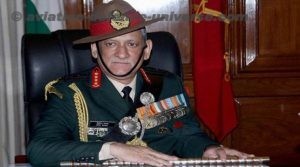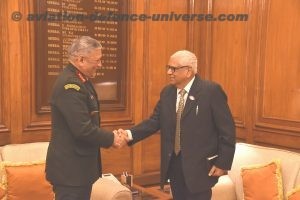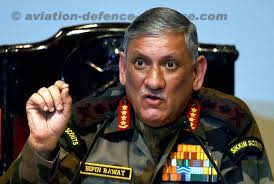- Many changes have taken place but one change remains the same that is your Task & Duty . You are required to ensure the security of this country against all odds”
- Field Marshal Sam Manekshaw
By Lt General Vinod Bhatia (Retd)
New Delhi. 13 January 2018. The 1.2 million strong Indian Army prepares to celebrate the 70th Army Day on 15th January, 2018, with pride, parades, ceremonies and paying homage to the martyrs in cantonments across the country. The celebrations also include a connect between the soldiers and the veterans, who flock the cantonments displaying their well won medals, miniature though, on their chests proud of the service they have rendered to the army and the nation. Reminiscing the many battles fought and their contributions in ensuring the security of the nation and its people, each story is narrated to motivate the serving soldiers to live and die for the ‘ NAM NAMAK AND NISHAN’ of their units, regiments and the country.
The national aim is to “ TRANSFORM INDIA TO A MODERN, PROSPEROUS AND SECURE NATION” . As security is a precursor to long term peace, stability and development , securing India is a national imperative. The army is mandated to ensure a secure India. The primary role of the army is to ensure national security, territorial integrity and unity, defending the nation from external aggression and internal threats. The Army Day is the occasion for the soldiers to rededicate themselves to the defence and service of the nation, and for the top brass to audit the performance and preparedness of the army, introspect and chart out the roadmap to meet present and future challenges as also to ensure the wellbeing of the soldiers. The Indian Army needs to be recognized for the sterling service to the nation “Service Before Self” being the motto.
2017 has been a landmark year for the army. The year commenced with General Bipin Rawat taking over as the 27th Chief of the largest volunteer army in the world. Overall, the year under his leadership has been good for the army and the nation, despite the PLA build up and war hysteria post Doklam, the increase in violence levels in the valley and an unprecedented spike in ceasefire violations along the Line of control (LoC). It was appreciated by the knowledgeable that the situation in the J&K will deteriorate in 2017. The agitational terrorism for once seemed to be winning with an apparently emboldened populace taking on the security forces with the ‘stone pelters’ effectively denying operational space as also dominating the social media. The Army Chief and his commanders must be given credit for handling a very delicate situation with an effective counter terrorism strategy, executing precise intelligence based operations with zero collateral damage.
The success is also attributed to a very high degree of cooperation and coordination among the army, police and CAPF. According to official figures, 210 terrorist have been neutralised by the security forces during counter-insurgency operations this year, which is the highest since 2010. In 2010, 270 militants were killed. However the number dropped to around 100 per year by the end of 2015. “This marks a huge landmark for establishing peace and stability in the state of J&K and our country,” Director General of Police (DGP) S P Vaid tweeted. Killing terrorist alone is not the correct strategy, the aim is to kill terrorism and this can only be done over time with sustained military operations backed by a political resolution to the problem.The success of the security forces in ensuring sub critical violence in Kashmir valley is a major contributory factor for the government to appoint Dineshwar Sharma as the interlocutor. Gen Bipin Rawat rewarding Maj Gogoi also reinforced the faith of the leaders in their Chief and the chain of command contributing to a more effective and assured leadership at the fighting and functional level.
The LoC was activated by the Pakistan army with the Nov 2003 ceasefire under severe stress. Reportedly there have been 780 ceasefire violations (CFVs) by Pakistan along the LoC. The army carried out immediate and effective retaliation. A successful year otherwise was marred by the martyrdom of a major and four soldiers in the Keri sector of Rajouri on 23 Dec. The ‘ Badla’ operations two days later were executed with military precision as the retaliation was immediately, effective and equitable.
The Army also demonstrated unmatched professionalism ensuring continued peace and tranquility along the sensitive Line of Actual Control (LAC) with China. The 73 day long ‘DOKLAM Standoff’ has been deliberated and discussed in various forums. China decided to change the status quo along the China – Bhutan border in the Doklam Plateau by constructing a road upto Jampheri ridge and thus posing a direct threat to the vulnerable Siliguri corridor, a narrow strip which connects eight and a half states and five crore people with mainland India. China resorted to a first ever demonstration of its three warfare strategy- Informational, legal and psychological war , threatening India with a repeat of 1962.
China however was surprised by a responsible and resolute Indian response. The credit for the peaceful resolution is due in equal part to India and China as also to Bhutan, at the politico-diplomatic and military levels. However, at ground zero it was the Indian army who stood face to face, eyeball to eyeball without either blinking or raising the ante. It needs to be understood that at high altitudes and Doklam is over 4000 meter, the temperatures are low and tempers high and hence a major part of the credit is due to the soldiers and military leaders of Indian Army for ensuring peace and tranquility under the most difficult and challenging of circumstances which also included an exceptional case of stone throwing between the patrol parties North of Pangong Tso in Eastern Ladakh. In the North East the army and the Assam Rifles continued its vigil and ensured relative peace in all the troubled states. The violence levels showed a steady decline and the situation in most states is on the border of public order and law and order.
The army is an important tool of defence diplomacy, conducting bilateral exercises with many nations including the immediate neighbourhood the US, Russian and UK army. India stands committed to assist the UN in the maintenance of international peace and security with a proud history of UN peacekeeping dating back to its inception in the 1950s. India has contributed nearly 180,000 troops, the largest number from any country, participated in more than 44 missions and 157 Indian peacekeepers have made the supreme sacrifice while serving in UN missions. India has also provided and continues to provide eminent Force Commanders for UN Missions. In 2017 India was the second largest troop contributor with over 8000 personnel deployed with 12 UN Peacekeeping Missions. The high standards of performance maintained by the Indian troop deployed on UN Missions under challenging circumstances have won them high regard and respect worldwide.
2017 is also marked by the army initiating a number of reforms to rebalance and redeploy the manpower. Based on the recommendations of the Shekatkar committee the army has affected long overdue organisational changes to enhance combat effectiveness by rebalancing the defence budget, integrating civil resources and infrastructure. The positive impact of these organisational changes will be visible in the mid to long term.
The army has also done more than its share in imbibing a sense of pride and discipline among the youth through the various NCC programmes and Army melas. The NCC needs to be expanded from the present strength of around 15 lac cadets to 25 lacs. The army has also contributed to adventure and sports activities, soldiers winning many a medals in various international events. The army though should be the last resort in ‘ Aid to Civil Authority’ but has by default become the first responder whether this is in aid to diffuse the situation in Panchkula, post the arrest of Gurmit ‘Ram Rahim’ or for disaster relief. On an average the army was requisitioned almost every week, a total of 47 times in 2017, 31 times for disaster relief and eight times each for restoring law and order and miscellaneous tasks, which also included the controversial construction of a railway foot over bridge.
The year also saw certain insensitive and irrational decisions by the Ministry of Defence (MoD). The MoD withdrew the grant of authorised rations, (wrongly termed as free rations) to all officers posted in peace areas, thus affecting a saving of a little over one crore rupees annually in the defence budget. If this was not enough in another move which is beyond comprehension, the MoD capped the reimbursement of tution and hostel fee to the next of kin of martyrs to a maximum of INR 10,000/- month. Earlier the government had authorised full reimbursement of education expenditure. There are nearly 3,200 students studying in schools, colleges and professional institutions who were beneficiaries under this scheme. Another major issue which is degrading the army effectiveness is the status equivalence in which the army finds its ranks being constantly and continuously downgraded vis a vis their civilian counterparts. This trend needs to be corrected as it not only demoralises the soldiers and erodes the moral authority of the military leadership, but also has made conjointly manned organisations like MES, Border Roads etc dysfunctional.
It is not possible to detail or even list the many contributions of the army to nation building, these are varied from sports to adventure, development of infrastructure and medical aid to people in the border areas, education to vocational training and above all being a proponent of the power of positive secularism. All these achievements have come at a great cost. In the 1947-48 war with Pakistan 1500 all ranks laid down their lives with another 3500 wounded. In the 1965 war 2902 all ranks were killed in action and 8444 wounded and in 1971, 3785 made the supreme sacrifice with 3198 wounded. 527 all ranks laid down their lives in the Kargil war with 1363 wounded. Since the beginning of the Pakistan sponsored proxy war in 1989, in J&K alone , over 5000 all ranks have been martyred in counter terrorist operations.
In addition to ensuring an effective defence and security of the nation, the army has many other contributions to nation building and the people. Recognized as “scrupulously apolitical”, the army’s major contribution post independence is in keeping the Indian nation and people united, despite externally aided insurgencies, religious fundamentalism and radicalisation, ethnic and caste based riots and many other fissiparous tendencies. The Indian army is well known for the ethos, virtues and values of duty, honour, country, discipline,dedication, integrity, loyalty, courage,commitment, respect, sense of sacrifice, patriotism, selfless service, moral values and ethics. They have earned India’s profound appreciation and reverence for their unwavering commitment to these value system in war and peace, both at home and abroad.
The Indian army takes pride in their calling and engage themselves wholeheartedly in the pursuit of professional excellence so that they can serve the nation with honour. Passionately patriotic, with an apolitical and secular ethos, the Indian Army is without doubt a strong and unyielding bastion for national unity and integrity. In the vitiated security environment within the country and the region, the army will continue to play a critical role in ensuring national security and nation building. The powers that be need to ensure that this great national institution, the Indian army is effective and well cared for.
(Lt. General Vinod Bhatia is former DGMO and currently Director Centre for Joint Warfare Studies. The views in the article are solely the author’s. He can be contacted at editor.adu@gmail.com)






























































































































